Qt Undo Framework
Qt undo/redo 框架
- 基于Command设计模式
- 支持命令压缩和命令合成
- 提供了与工具包其他部分融合很好的widgets和actions
术语(Terminology)
- Command - 对文档的一个作用行为,比如
- 图像编辑器的模糊操作
- 文本处理器的剪切操作
- 采样编辑器的最大化操作
- Undo-stack - commands的堆栈
- Document - 被应用程序编辑的内部数据,比如
- 音频编辑器中的waveform(波形)
- 图像编辑器中的bitmap(位图)
基本的undo stack操作
- Push
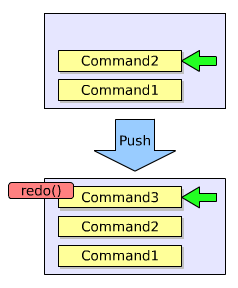
- Undo

- Redo
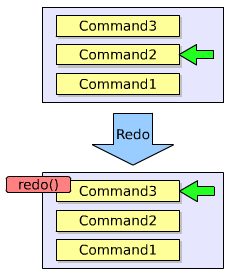
注意,push可能会删掉一些操作,如图
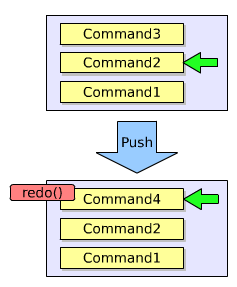
类们
只有四个类!
- QtUndoCommand - 用于修改document的对象的基类
- QtUndoStack - QtUndoCommand对象的堆栈
- QtUndoGroup - undo堆栈的组。很多应用程序允许用户同时打开超过一个文档,该类允许你把一组undo堆栈按一单个stack对待。
- QtUndoView - 继承自QListWidget,用来展示undo堆栈的内容,以字符串形式
实例
前提说明:下面这个例子,我们将为一个文本编辑器实现undo/redo;文档我们就用一个简单的QString来代表;我们先实现文档中插入字符这样一个command
commands的实现
插入字符操作
class InsertChars : public QUndoCommand
{
public:
InsertChars(int index, const QString &chars, QString *document)
: QUndoCommand("Insert characters") {
m_index = index;
m_chars = chars;
m_document = document;
}
virtual void redo() {
m_document->insert(m_index, m_chars);
}
virtual void undo() {
m_document->remove(m_index, m_chars.length());
}
private:
int m_index;
QString m_chars;
QString *m_document;
};
删除字符操作
class RemoveChars : public QUndoCommand
{
public:
RemoveChars(int index, int count, QString *document)
: QUndoCommand("Remove characters") {
m_index = index;
m_count = cout;
m_document = document;
}
virtual void redo() {
m_removedChars = m_document->mid(m_index, m_count);
m_document->remove(m_index, m_count);
}
virtual void undo() {
m_document->insert(m_index, m_removedChars);
}
private:
int m_index, m_count;
QString m_removedChars;
QString *m_document;
};
在文本编辑器中使用
MyEditor::MyEditor(QWidget *parent) : QWidget(parent) {
// …
m_document = new QString;
m_stack = new QUndoStack(this);
m_toolBar->addAction(m_stack->createUndoAction);
m_toolBar->addAction(m_stack->createRedoAction);
// …
}
void MyEditor::keyPressEvent(QKeyEvent *event) {
QString chars = events->text();
int index = cursorIndex();
switch (event->key()) {
case Qt::Key_Backspace:
if (index > 0)
m_stack->push(new RemoveChars(index-1, 1, m_document));
break;
case Qt::Key_Delete:
if (index < m_document.length())
m_stack->push(new RemoveChars(index, 1, m_document));
break;
default:
if (!chars.isEmpty())
m_stack->push(new InsertChars(index, chars, m_document));
break;
}
}
command的压缩(compression)
命令压缩,是一种把若干个commands压成一个command的行为。 典型的案例就是文本编辑器中输入一大堆文字,撤销,把这一大堆都撤销了。
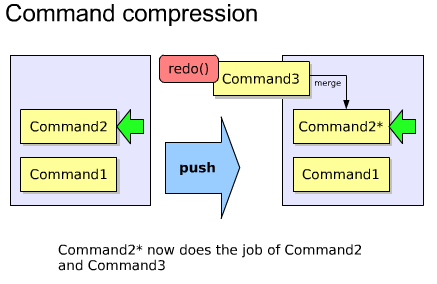
主要用到了QUndoCommand的id()和mergeWith()方法。代码如下
static const int InsertCharsId = 1000;
static const int RemoveCharsId = 1001;
//...
int InsertChars::id() const {
return InsertCharsId;
}
bool InsertChars::mergeWith(const QCommand *command) {
// 该类型转换是安全的,因为stack检查过id()了
InsertChars *other = static_cast<InsertChars* > (command);
// 只有当其他插入的字符在我的字符后面时,才merge
if (m_index + m_chars.length() != other->m_index)
return false;
// 把它merge了
m_chars.append(other->m_chars);
return true;
}
command的合成(composition)
也就是传说中的宏(macros)
通过合并一系列简单的commands,从而创建复杂的commands
主要是用到了QUndoStack的beginMacro()和endMacro()方法。代码如下
void MyEditor::replace(const QString &oldChars, const QString &newChars) {
if(!m_document->contains(oldChars))
return;
QString title = QString("Replace '%1' with '%2'").arg(oldChars).arg(newChars);
m_stack->beginMacro(title);
int index = 0;
for(;;) {
index = m_document->indexOf(oldChars, index);
if(index == -1)
break;
m_stack->push(new RemoveChars(index,oldChars.length(), m_document));
m_stack->push(new InsertChars(index, newChars, m_document));
index += newChars.length();
}
m_stack->endMacro();
}
高级command合成
你大部分的需要,beginMacro()和endMacro()都能充分满足。
每个command可以有很多子commands
通过添加子command,构成一个复杂的command
自定义的command合成有很大益处,你可以在push到stack之前,逐步构建command
合成命令的undo顺序如下

合成命令的redo顺序如下
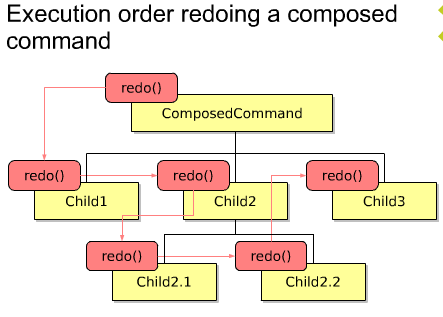
QUndoCommand* MyEditor::createReplaceCommand(const QString &oldChars, const QString &newChars) {
QUndoCommand *replaceCommand = new QUndoCommand(QString("Replace '%1' with '%2'").arg(oldChars).arg(newChars));
int offset = 0;
int index = 0;
for(;;) {
index = m_document->indexOf(oldChars, index);
if (index == -1)
break;
new RemoveChars(index + offset, oldChars.count(), m_document, replaceCommand);
new InsertChars(index + offset, newChars, m_document, replaceCommand);
index += newChars.cout();
offset += newChars.count() - oldChars.cout();
}
return replaceCommand;
}
QUndoGroup
一个应用程序,一般有若干个打开的文档,每个都拥有他们自己的undo stack。
这些undo stack们可以放到一个undo group里
该组group里的stack可以使用QUndoStack的setActive ()方法将自己设置为active stack。
在同一时间,只能有一个stack是active的。
void MyEditor::MyEditor(QWidget *parent) : QWidget(parent)
{
//...
m_undoGroup = new QUndoGroup(this);
m_toolBar->addAction(m_undoGroup->createUndoAction(this));
m_toolBar->addAction(m_undoGroup->createRedoAction(this));
//...
}
Document *MyEditor::createDocument() {
Document *doc = new Document(this);
m_documents.append(doc);
m_undoGroup->addStack(doc->undoStack());
return doc;
}
bool Document::event(QEvent *event) {
if( event->type() == QEvent::WindowActivate)
m_undoStack->setActive(true);
// ..
return QWidget::event(event);
}
Tips
- 按照commands来设计实现你的应用程序功能---后期很难增加undo/redo
- Undo commands不应该储存指向document中实际对象的指针---储存其拷贝或者储存足够必要的用于重创建新对象的信息
- 如果你非得想让commands里储存指向document中对象的指针时,你必须做到如下:
- 当这些对象在document中被删除的时候,获得对象的多有权
- 当该command实例被销毁时,delete掉你拥有的那个对象
- 如果你十分渴望能改变或者移除stack里已经被push的command的话,你很可能会犯以下错误:
- 你尝试在不只一个文档的情况下使用一个undo堆栈来代表。(原文You are trying to use one undo stack for something that needs to be represented as more than one document)
- 你的command不是atomic(应该就是说该命令是有若干命令合成或压缩的,不是最最基本的命令)
- 当命令修改了文档,立马更新该文档的state,使用QUndoStack的indexChanged()信号
- 该更新信号不应该从command里发射。



【推荐】国内首个AI IDE,深度理解中文开发场景,立即下载体验Trae
【推荐】编程新体验,更懂你的AI,立即体验豆包MarsCode编程助手
【推荐】抖音旗下AI助手豆包,你的智能百科全书,全免费不限次数
【推荐】轻量又高性能的 SSH 工具 IShell:AI 加持,快人一步
· 开发者必知的日志记录最佳实践
· SQL Server 2025 AI相关能力初探
· Linux系列:如何用 C#调用 C方法造成内存泄露
· AI与.NET技术实操系列(二):开始使用ML.NET
· 记一次.NET内存居高不下排查解决与启示
· 阿里最新开源QwQ-32B,效果媲美deepseek-r1满血版,部署成本又又又降低了!
· 开源Multi-agent AI智能体框架aevatar.ai,欢迎大家贡献代码
· Manus重磅发布:全球首款通用AI代理技术深度解析与实战指南
· 被坑几百块钱后,我竟然真的恢复了删除的微信聊天记录!
· 没有Manus邀请码?试试免邀请码的MGX或者开源的OpenManus吧